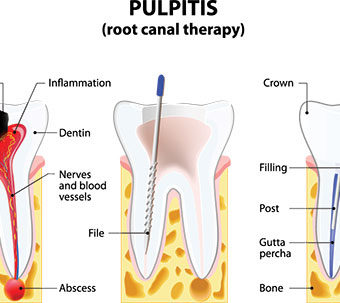According to the most recent American Dental Association Survey of Dental Services, almost 41,000 root canals are performed every day in the U.S. and close to 15 million are done over the course of a year. Since the success rate of endodontic treatment is well over 90%, and because maintaining a patient’s natural dentition is essential to overall oral health, root canal therapy as opposed to having the involved tooth extracted is a widely recommended option in care.
A root canal procedure is indicated when the vital tissues, which are referred to as the “pulp,” become inflamed or infected in response to an injury, deep dental decay or an advanced case of periodontal disease. Every tooth has either a single, central canal or multiple ones that contain the blood vessels, nerves, and connective tissue, which comprise the dental pulp. These pulp tissues are essential for a tooth to develop, mature and erupt into place. Once a tooth has emerged, the dental pulp provides nourishment to keep the tooth vital and serves to alert an individual that decay or some other type of damage is affecting the tooth. Having sensitivity to various stimuli like biting down and eating or drinking hot or cold items is a warning from the nerves inside your tooth that dental disease or trauma is taking a toll on the tooth, or infection is brewing. The degree of pain that you experience depends on the extent of the damage and nerve involvement.
When Is A Root Canal Procedure Recommended?
A root canal procedure is recommended when the dental pulp has become irreversibly damaged or has died, but enough healthy tooth structure and bone support remains around the tooth to save and maintain it. Since a fully developed tooth does not require the dental pulp to remain functional, a natural tooth can be effectively preserved with a root canal. During this procedure, the dentist removes the diseased dental pulp, cleans the internal portion of the tooth, and then fills all the prepared canals with a biocompatible filling material. Once the canals have been sealed and the tooth is symptom-free, the tooth will need a suitable restoration to reestablish its appearance and function and to strengthen it to withstand the forces generated in the mouth. With proper care, a tooth that has received a root canal therapy and restoration can be maintained for many years.
Modern technology and advanced methods of care make getting a root canal procedure as comfortable, and no more complex, than getting a routine dental filling. While some root canals can be completed in one visit, others may involve 2 or 3 appointments. How many visits it takes to complete a root canal procedure depends on factors such as the number of canals in a tooth, their anatomy and whether an active infection is present.
When root canal therapy is recommended, it is important to get timely care. If left untreated, the damage to a tooth and the risk of infection increase, as do the consequences to oral health and overall well being.

